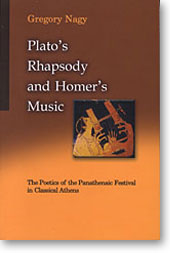 《柏拉图的史诗吟诵与荷马的音乐:古典时期雅典的泛雅典娜赛会及其节日的诗学》 (Plato’s Rhapsody and Homeric Music: The Poetics of the Panathenaic Festival in Classical Athens, Washington, D.C. and Athens:CHS, Harvard, 2002) 作者:格雷戈里·纳吉(Gregory Nagy) 泛雅典娜赛会(The festival of the Panathenaia),每年夏天在雅典举行,旨在庆祝这座城市的守护神──雅典娜的生日。泛雅典娜大赛会(The Great Panathenaia)则每四年举办一次。雅典娜,希腊智慧和技艺的女神,便成为职业性史诗吟诵者即rhapsodes演述荷马《伊利亚特》和《奥德赛》的背景。在既有的文献资料中,柏拉图的著述是我们了解这些演述的主要来源。通过他的引述,历史上荷马传统的一个关键性阶段能够得以重构。通过柏拉图的眼睛,荷马在古典时期的雅典是怎样“登台演述”的情景也能够再次变为虚拟的现实。 本书考察了柏拉图作为荷马式演述及其文化遗存的一位专门家及其全部的证言。柏拉图倾听语言——在此指的是史诗吟诵者(rhapsodes)这类大师级“工匠”的技艺性语言——的耳朵堪称机敏,通过这双好耳朵而汇集起来的种种表述真实可信,回响着史诗吟诵者彼时彼地实践其艺术的言谈话语。 本书重点讨论的柏拉图著述是《伊安篇》(Ion)、《蒂迈欧篇》(Timaeus)和《克里底亚篇》(Critias)。一些研究《蒂迈欧篇》的专家已经提出过这样的看法,柏拉图当时完成的这篇杰作一定是有意为之,通过其人物将之描述为颂神诗(humnos),以此作为献给雅典娜的颂辞。编织的隐喻潜藏在颂神诗中,但却明显地表现为泛雅典娜赛会上祭献给雅典娜女神的长袍(peplos),这同样适用于荷马诗歌:这些诗篇也被形象化地描述为颂神诗,指归为在雅典娜永恒自新的诞辰之日及其祭庆的节日场合实现永恒的再编织。 Plato's Rhapsody and Homer's Music: The Poetics of the Panathenaic Festival in Classical Athens Gregory Nagy The festival of the Panathenaia, held in Athens every summer to celebrate the birthday of the city's goddess, Athena (the Great Panathenaia was held every four years), was the setting for performances of the Homeric Iliad and Odyssey by professional reciters or "rhapsodes." The works of Plato are our main surviving source of information about these performances. Through his references, a crucial phase in the history of the Homeric tradition can be reconstructed. Through Plato's eyes, the "staging" of Homer in classical Athens can once again become a virtual reality. This book examines the overall testimony of Plato as an expert about the cultural legacy of these Homeric performances. Plato's fine ear for language--in this case the technical language of high-class artisans like rhapsodes--picks up on a variety of authentic expressions that echo the talk of rhapsodes as they once practiced their art. Highlighted among the works of Plato are the Ion, the Timaeus, and the Critias. Some experts who study the Timaeus have suggested that Plato must have intended this masterpiece, described by his characters as a humnos, to be a tribute to Athena. The metaphor of weaving, implicit in humnos and explicit in the peplos or robe that was offered to the goddess at the Panathenaia, applies also to Homeric poetry: it too was pictured as a humnos, destined for eternal re-weaving on the festive occasion of Athena's eternally self-renewing birthday. Gregory Nagy is the Jones Professor of Classical Literature and Professor of Comparative Literature, Harvard University, and the Director of the Center for Hellenic Studies, Trustees for Harvard University. (责任编辑:admin) |
